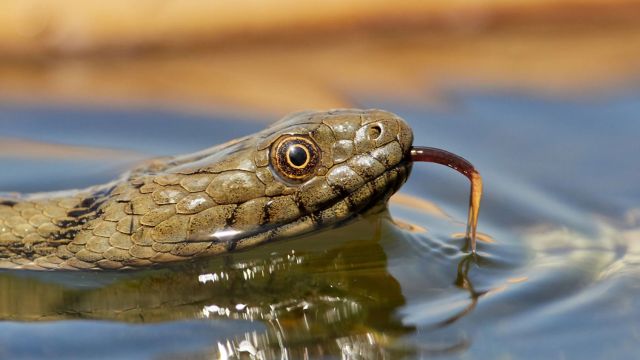Arizona, with its sun-drenched landscapes and diverse ecosystems, is home to an astounding variety of wildlife, including a significant population of snakes. In fact, the state boasts 41 species and subspecies of snakes, 20 of which are venomous, including 13 types of rattlesnakes.
This makes Arizona second only to Texas in terms of snake diversity and the leader in venomous varieties nationwide. Given Arizona’s extensive network of 128 lakes, the intersection of aquatic and reptilian residents is not only inevitable but fascinating.
Lake Mead: A Reptilian Refuge
Lake Mead, created by the damming of the Colorado River at the Hoover Dam, is the largest artificial reservoir in the United States by water volume and trails only behind Lake Powell in surface area. Stretching over 65 miles in length and 9.3 miles at its widest, Lake Mead’s expansive 550-mile shoreline straddles southeastern Nevada and northwestern Arizona.
This vast area is a haven for snakes, including four venomous species—the Mojave, western diamondback, southwestern speckled, and sidewinder rattlesnakes. Non-venomous species, like the common kingsnake, also thrive here, benefiting from the diverse habitats within the Lake Mead National Recreation Area, America’s oldest recreational area.
Lake Powell: A Snake Enthusiast’s Paradise
The iconic Lake Powell, another massive reservoir on the Colorado River, extends 186 miles in length with a shoreline that nears 2,000 miles. It is the largest U.S. reservoir in terms of surface area. This vast and varied landscape supports a wide range of snake species, from the non-venomous black-necked garter snake and glossy snake to several subspecies of the western rattlesnake, including the Hopi and Grand Canyon varieties.
The expansive environment provides a rich tableau not just for aquatic activities but also for wildlife spotting, including these remarkable reptiles.
Lake Pleasant: A Misnomer or a Marvel?
Despite its idyllic name, Lake Pleasant, situated less than an hour north of Phoenix, is a hotbed for snake activity, particularly during the warmer months. This reservoir on the Agua Fria River, known for its recreational offerings like hiking, boating, and camping, also draws snakes to its shores.
Memorial Day weekend often coincides with increased snake sightings, as both temperatures and tourist activities peak. The presence of snakes such as the non-venomous gopher snake, which has been known to boldly approach human visitors, adds a wild twist to this otherwise serene setting.
Mittry Lake: A Cross-State Serpent Sanctuary
Nestled in Arizona’s southwest corner, near the confluence of the California border and the Colorado River, Mittry Lake spans 600 acres of water and 2,400 acres of diverse habitats. This area, which links to main water bodies through snaking channels, has become a vital ecosystem for both local and invasive species.
Notably, the southern banded water snake, an invasive species, has thrived here, much to the concern of local wildlife authorities. The lake’s environment, similar to the swamps of Florida, provides an ideal setting for these non-venomous snakes to proliferate.
Lake Mohave: A Desert Oasis Shared with Serpents
Located just south of Lake Mead, Lake Mohave is a slender reservoir also formed by the Hoover Dam on the Colorado River. Part of the Lake Mead National Recreation Area, it shares many of the same reptilian species. However, it’s also a place of serene beauty, popular among water sports enthusiasts and nature lovers.
The lake’s 200 miles of shoreline offer sandy coves and hidden gems like ancient petroglyphs, making it a perfect spot for exploration and enjoyment, even with its reptilian residents.
In conclusion, while Arizona’s lakes may be renowned for their serpentine inhabitants, these bodies of water offer much more than just a habitat for snakes. They provide a sanctuary for a diverse range of species and a playground for human adventurers. By respecting wildlife and practicing safety, visitors can enjoy the natural beauty and recreational opportunities these lakes offer without undue fear of their slithery co-inhabitants.

